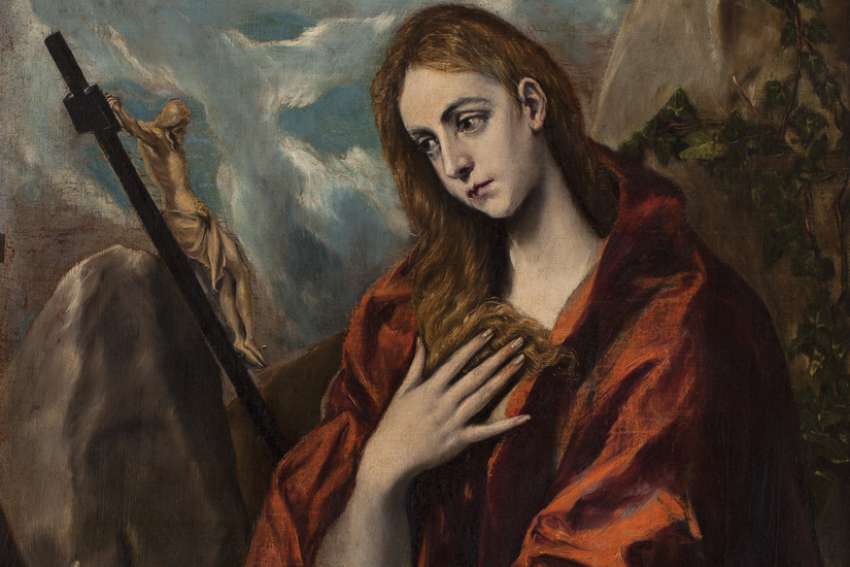“Picasso is a Spaniard and a Catholic. One must recognize that. It is undeniable. It is central to his formation as a human being,” said Art Gallery of Ontario curator Kenneth Brummel.
On now to Jan. 16, Brummel is presenting a major exhibition of Picasso’s early, blue period paintings under the title “Picasso: Painting the Blue Period.” The exhibition presents, as one of the keys to understanding what this master of modernism was doing from 1901 to 1903, two paintings by the Greek-born Spanish Counter-Reformation painter El Greco. These two late 16th- and early 17th-century paintings — Penitent Magdalene With The Cross and Tears of St. Peter — were central to the teenaged Picasso’s formation as an artist. The young artist saw himself as heir to El Greco both in terms of artistic virtuosity and his claim on the Spanish Catholic imagination.
Both paintings once belonged to Picasso’s mentor Santiago Rusiñol, founder of Catalan modernisme. When a friend acquired the paintings in Paris for Rusiñol, the painter had them enthroned and then paraded through the streets of Barcelona. They were treated as icons, worthy of devotion. Catalan painters made pilgrimages to Rusiñol’s home to see them.
In his late teens and 20s, Picasso was naturally drawn to Catholic subjects.
“This is a young boy whose first exposure to painting was El Greco and the Prado (Museum in Madrid),” points out Brummel. “You think of the Prado and you think of what you see in the Prado. Well, you see a lot of things. You see a lot of Christs; you see a lot of Virgin Marys. He grew up with this long, Spanish tradition of religious painting — Counter-Reformation Catholic painting with pathos on full display.”
After visiting the Saint-Lazarre hospital in Paris, where he was himself penniless after a failed exhibition, then returning home to Barcelona and seeing a sudden increase of homeless on the streets, Picasso turned his artistic eye to the fate of the poor — particular poor, single women reduced to begging or working for less-than-subsistence wages.
“Even within anarchist circles in Barcelona, very leftist agitators and thinkers and writers — they did invoke Catholicism as a justification for social justice,” said Brummel.
So when Picasso decided to paint a homeless beggarwoman crouching in the street, he naturally drew on El Greco’s very Catholic image of a penitent Mary Magdalene. El Greco’s painting was steeped in the false legend of Mary Magdalene as a reformed prostitute. For Catalan Catholics at that time, Mary Magdalene’s story stood at the crossroads of the sacred and the profane — a fallen woman who hungers for God.
“In the popular imagination, in the population of Barcelona in the 1890s and the aughts of the 20th century, the content of this painting mattered,” said Brummel.
In Crouching Beggarwoman, Picasso borrows the bowed head, narrow silhouette and atmosphere of longing and regret from El Greco’s painting of the Penitent Magdalene. Picasso echoes El Greco’s colour choices and casts the figure of the woman against a near-abstract bed of colours.
He was urging his Catalan, Catholic audience to make the connection, said Brummel. In all his paintings of poor, homeless women, he wanted viewers “to regard these downtrodden women as saints, as figures worthy of reverence, as almost devotional figures in front of which one would meditate and maybe contemplate on one’s own actions,” Brummel said.
Picasso’s attention to women throughout 1901 and 1902 is impossible to miss.
But it was something he shared with other painters concerned with social justice.
“Those who wanted to redress issues of class and inequality, those who wanted to have viewers of art focus on issues of poverty, (for them) the single woman — it is, I would have to say, a poignant trope when you think of single women saddled with children, having to work, living in poverty. It’s a universal, allegorical image that anyone can relate to,” Brummel said.
After two years of concentrating on women, Picasso in 1903 turns to painting men — specifically veterans returned from the Spanish-American War, many blind and otherwise maimed. Though still generations away from recognizing post-traumatic stress syndrome, Picasso understood that these men had been ruined for life by one of the earliest examples of industrial-scale warfare.
El Greco’s Tears of St. Peter becomes the young artist’s source.
“He uses El Greco to try to create a pathos around these blind men, these maimed men, so that you as a spectator don’t just empathize with them, but I think also become indignant on their behalf,” said Brummel.
For Picasso and the generation of young artists surrounding him in Barcelona and Paris, Catholic culture was always at hand to provide a visual language for their concerns.
“These were extremely progressive Catholics, who used their beliefs as a justification for thinking about social justice and for redressing the ills of industrial society,” Brummel said.
Fast forward a couple decades and the progressive Catholics lost out to Generalisimo Francisco Franco and the fascists, who declared a culture war on modern art and artists. An increasingly rigid and reactionary Church in Spain went along with them. For Picasso, who imbued his faith with art and his art with faith, this was a horror.
“When you believe in the power of art and its autonomy, and you think that art is capable of enacting social change, and you are almost asking people to worship a painting because you believe it has power, there is a certain belief system that is very similar to religion,” said Brummel. “As a modernist, which is what Picasso is above anything else, I think the interdiction against abstract forms by fascist governments in the 1930s was an assault on his being.”


